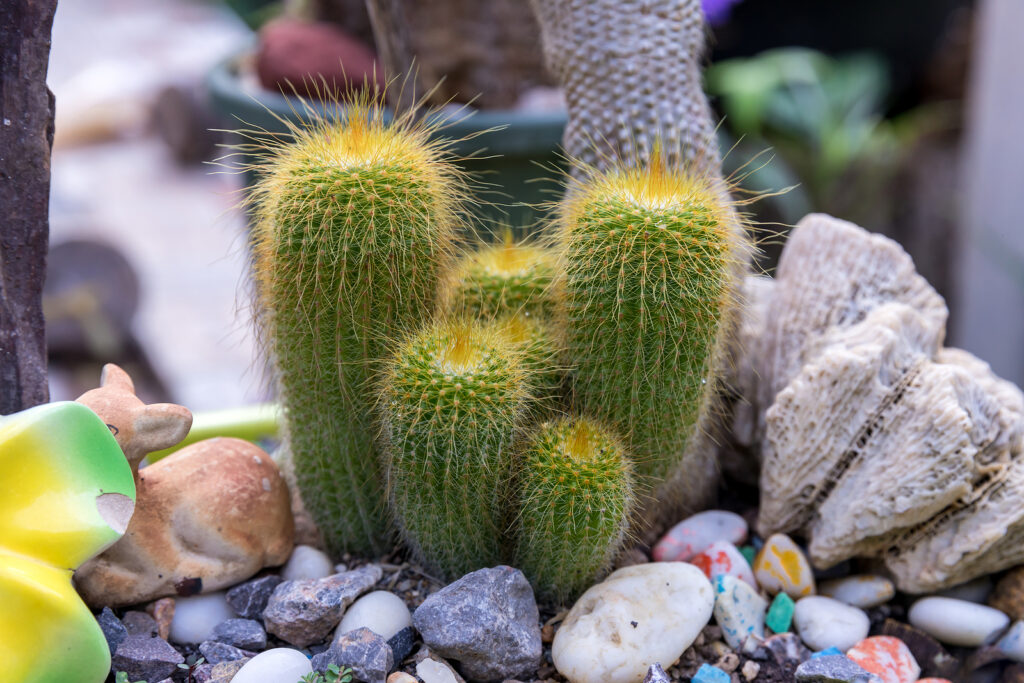Echinopsis–commonly called Easter lily or sea urchin cactus, other species are called barrel cactus– is a heavily spined cactus with prominent ribs and dramatic, trumpet-shaped flowers. Echinopsis cacti commonly grow no more than a foot tall, but the flowers can be as large as 4 inches wide and 8 inches long.
Most Echinopsis species bloom at night, often just for a day, though some remain open for 36 hours or more. Echinopsis is very popular with experienced cactus collectors as well as beginners.
Echinopsis can be grown in a commercial cactus mixture. It needs ample fertilizer and water during the growing season to assure best growth. Echinopsis grows well indoors given bright light.
Echinopsis now includes the Lobivia genus. The flowers of most Echinopsis are larger than Lobivia with a distinct circle of upper stamens at the mouth.
Echinops have been cultivated for over 100 years and most available today are hybrids. Echinopsis is often hybridized making immediate identification somewhat difficult.

Get to know Echinopsis
- Plant type: Cacti, Easter lily cactus, sea-urchin cactus
- Hardiness temperature: 30℉ (-1.7℃); many species survive the winter in near-freezing temperatures—some even in snow.
- Optimal growing temperature: day, 75° to 85°F (24° to 29°C); night, 65° to 70°F (18° to 21°C).
- Shape and size: Plants are globular or longish; later on they are short-columned.
- Flowers: Blooms are usually 8 inches long and in shades of red, pink, or white. Most species bloom at night, often just for a day, though some flowers remain open for 36 hours or more.
- Bloom time: Spring and summer at night
- Common name: Easter lily cactus, barrel cactus, red crown, fire crown
- Genus name: Echinopsis
- Family name: Cactaceae
- Origin: South America, Argentina
Planting Echinopsis
- Echinopsis should be grown in a warm location. In the summer it should be sunny with slight protection from full sunshine.
- Plant Echinopsis in full, indirect sun.
- Indoors grow Echinopsis in full sun, with 4 hours direct sun daily, from southern exposure. Fresh air circulation is important.
- Grown indoors Echinopsis wants a sunny spot with some humidity.
- Echinopsis needs a cool and dry winter rest period.
- Grow Echinopsis in rich porous soil; a commercial cactus mix is best.
How to water and feed Echinopsis
- Water Echinopsis regularly during the growing season, but the soil should not stay wet. Let the soil dry between waterings.
- Echinopsos wants humidity of 30% to 35%.
- Withhold water from Echinopsis during the winter rest period
- Feed Echinopsis with a cactus fertilizer during the growing season every 6 weeks while in bloom, with low-nitrogen, high-potassium fertilizer.

Echinopsis care
- Repot Echinopsis when the plant crowds the container.
- Echinopsis can be somewhat rot-prone if planted in a shallow pot.
- Check for aphids, mealybugs, spider mites, scale. Also, be alert for fungus disease.
- Echinopsis rests from fall to early spring. Place the plant in a cool, bright location where it receives 5 hours of sun daily. Decrease water; withhold fertilizer.
- Propagate Echinopsis from seed; plants produce offsets freely.
Echinopsis species to grow
- Echinopsis albispinosa. Gray, 6-inch stems, either single or with offsets. Curved, dark brown spines turn white at maturity. Large white flowers reach 8 inches long.
- E. calochiora (shinning ball). Small globular plant bears long, near-white flowers often bigger than itself. Yellow radial spines, usually stout and needle-shaped, contrast against bright green stems.
- E. eyriesii. Gray-green body with radial brown spines; its white flowers are sometimes flushed with purple.
- E. lonlspina. Stout, yellowish-brown spines grow from deeply undulated ribs. Flowers are many-petaled, slender, white.
- E. multiplex (Easter lily cactus, barren cactus). Long-tubed, sweetly scented, pale pink flowers can reach 10 inches long.
- E. rodotricha. Can grow to 2 feet tall or more, unusually tall for an Echinopsis. Curved slender spines, 6-inch-long white flowers.
- E. tubiflora. Inch-long central spines are yellow with black tips; large white flowers reach 4 inches wide, 10 inches long.















